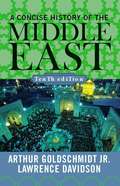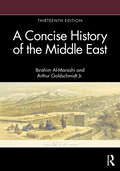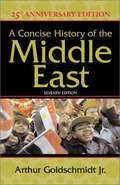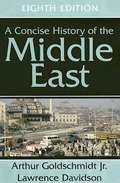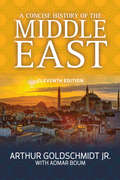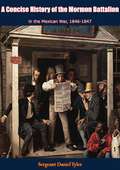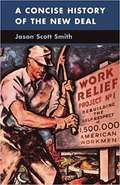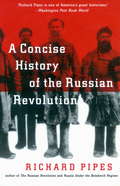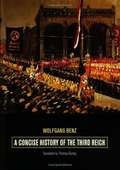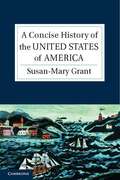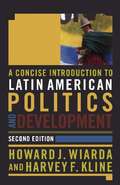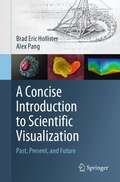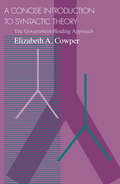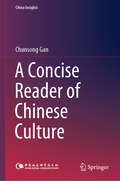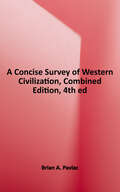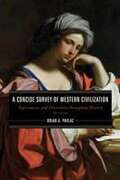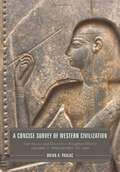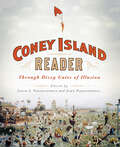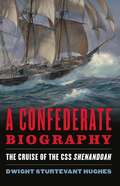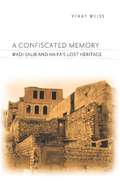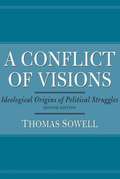- Table View
- List View
A Concise History of the Middle East
by Lawrence Davidson Arthur Goldschmidt Jr.The Arab Spring unexpectedly developed in late 2010 with peaceful protests in a number of Arab countries against long-standing, entrenched regimes, and rapid political change across the region ensued. The Arab Spring: Change and Resistance in the Middle East examines these revolutions and their aftermath. Noted authorities writing specifically for this volume contribute chapters focusing on countries directly or indirectly involved, illuminating the immediate and long-term impacts of the revolutions in the region and throughout the world. A thoughtful concluding chapter ties together key themes, while also delineating persistent myths and misinterpretations. This is an essential volume for students and scholars of the Middle East, as well as anyone seeking a fuller understanding of region and what may lie ahead. Resources for instructors are available online at westviewpress. com, including an updated bibliographic essay and test questions.
A Concise History of the Middle East
by Ibrahim Al-Marashi Arthur Goldschmidt Jr.A Concise History of the Middle East provides a comprehensive introduction to the history of this region. Spanning from the pre-Islamic era to the present, it explores the evolution of Middle Eastern institutions and culture, the influence of European colonialism and Western imperialism, regional modernization efforts, the struggle of various peoples for political independence, the Arab–Israeli conflict, the reassertion of Islamist values and power, the issues surrounding the Palestinian Question, and the Middle East following 9/11, the 2011 Arab uprisings, and the regional crisis that erupted after 7 October 2023.The thirteenth edition has been fully revised to reflect the most recent events in, and concerns of, the region, including its future in the face of climate change and challenges in Iraq, and developments in the Israeli–Palestinian conflict. In addition, the important role of Middle Eastern women in the history of the region is woven into the narrative. New parts and part timelines will help students grasp and contextualize the long and complicated history of the region.With updated biographical sketches and a new concluding chapter, this book remains the quintessential text for students of Middle East history.
A Concise History of the Middle East (10th edition)
by Lawrence Davidson Arthur Goldschmidt Jr.The tenth edition of this widely acclaimed text by Arthur Goldschmidt Jr. and Lawrence Davidson has been revised to reflect the latest scholarship and the most recent events in the Middle East. As an introduction to the history of this turbulent region from the beginnings of Islam to the present day, the book is distinguished by its clear style, broad scope, and balanced treatment. It focuses on the evolution of Islamic institutions and culture, the influence of the West, the modernization efforts of Middle Eastern governments, the struggle of various peoples for political independence, the course of the Arab-Israeli conflict, the reassertion of Islamic values and power, the issues surrounding the Palestinian Question, and the roles of Iraq and Iran in the post-9/11 Middle East. The tenth edition includes a new chapter, "In the Season of Arab Discontent," that outlines the achievements and problems created by the recent Arab uprisings. In addition, earlier chapters have been streamlined for more accessible reading, and two popular study aids, the chronology and the glossary, have been revised. Resources for instructors are available online at www.westviewpress.com, including an updated bibliographic essay and test questions.
A Concise History of the Middle East (7th edition)
by Arthur GoldschmidtThe seventh edition of Arthur Goldschmidt's widely acclaimed text has been extensively revised to reflect the latest scholarship and the most recent events in the Middle East, including a refined discussion of the life and mission of the Prophet Muhammad and a clarification of key aspects of the Palestinian-Israeli conflict. As an introduction to the history of this turbulent region from the beginnings of Islam to the present day, the text is distinguished by its clear style, broad scope, and balanced treatment. Written for college students, the text assumes no prior knowledge of Middle Eastern history. It focuses on the evolution of Islamic institutions and culture, the influence of the West, the modernization efforts of Middle Eastern governments, the struggle of various peoples tor political independence, the course of the Arab-Israeli conflict, the reinsertion of Islamic values and power, the aftermath of the Gulf War, and issues surrounding the Palestinian Question.
A Concise History of the Middle East (8th edition)
by Lawrence Davidson Arthur GoldschmidtThis book focuses on the evolution of Islamic institutions and culture, the influence of the West, the modernization efforts of Middle Eastern governments, the struggle of various peoples for political independence, the course of the Arab-Israeli conflict, the reassertion of Islamic values and power, the aftermath of the Gulf War, and issues surrounding the Palestinian Question.
A Concise History of the Middle East: Eleventh Edition
by Arthur Goldschmidt Jr. Aomar BoumAn introduction to the history of this turbulent region from the beginnings of Islam to the present day, this widely acclaimed text by Arthur Goldschmidt Jr. is distinguished by its clear style, broad scope, and balanced treatment. This book explores the evolution of Islamic institutions and culture, the influence of the West, the modernization efforts of Middle Eastern governments, the struggle of various peoples for political independence, the Arab-Israeli conflict, the reassertion of Islamic values and power, the issues surrounding the Palestinian Question, and the post-9/11 Middle East. The eleventh edition has been fully revised to reflect the most recent events in, and concerns of, the region, including an expanded and more nuanced discussion of the "War on Terrorism" and the Arab uprisings, coverage of the rise of ISIS, and a new chapter on the growing environmental problems of the region. In addition, the authors have incorporated new scholarship on the early history to provide a fuller picture of the political shifts and socioeconomic concerns of that time. With updated bibliographical sketches, chronology and glossary, A Concise History of the Middle East remains an essential text for students of Middle East history.
A Concise History of the Middle East: Eleventh Edition
by Arthur Goldschmidt Jr. Aomar BoumAn introduction to the history of this turbulent region from the beginnings of Islam to the present day, this widely acclaimed text by Arthur Goldschmidt Jr. is distinguished by its clear style, broad scope, and balanced treatment. This book explores the evolution of Islamic institutions and culture, the influence of the West, the modernization efforts of Middle Eastern governments, the struggle of various peoples for political independence, the Arab-Israeli conflict, the reassertion of Islamic values and power, the issues surrounding the Palestinian Question, and the post-9/11 Middle East. The eleventh edition has been fully revised to reflect the most recent events in, and concerns of, the region, including an expanded and more nuanced discussion of the "War on Terrorism” and the Arab uprisings, coverage of the rise of ISIS, and a new chapter on the growing environmental problems of the region. In addition, the authors have incorporated new scholarship on the early history to provide a fuller picture of the political shifts and socioeconomic concerns of that time. With updated bibliographical sketches, chronology and glossary, A Concise History of the Middle East remains an essential text for students of Middle East history.
A Concise History of the Mormon Battalion in the Mexican War, 1846-1847
by John Taylor Sergeant Daniel Tyler Thomas Leiper KaneTyler's narrative has long been considered the authoritative work on this heroic battalion of Mormon volunteers. The battalion, numbering about 500 men, was organized at Council Bluffs, Iowa, in July 1846. After reaching Santa Fe, they headed to California following the Gila River. They experienced, as reflected in Tyler’s vividly written account, a journey filled with unbelievable hardship. Thirst, starvation, heat, and freezing cold were their constant companions." The reached San Diego in January 1847 and, though they never saw combat, they "established Fort Moore in Los Angeles and strengthened the American hold on California. In addition to telling the story of the trek west, Tyler provides and important overview of the bitter rivalry between Stephen Watts Kearny and John C. Fremont for political control of newly conquered California; life in the pueblos of San Diego and Los Angeles; the return journey to Salt Lake City; and the role of several 'Battalion Boys' who were at Sutter's Mill on that fateful January 1848 morning when John Marshall discovered gold."—Zamorano 80
A Concise History of the New Deal
by Jason Scott SmithDuring the 1930s, Franklin D. Roosevelt's New Deal carried out a program of dramatic reform to counter the unprecedented failures of the market economy exposed by the Great Depression. Contrary to the views of today's conservative critics, this book argues that New Dealers were not "anticapitalist" in the ways in which they approached the problems confronting society. Rather, they were reformers who were deeply interested in fixing the problems of capitalism, if at times unsure of the best tools to use for the job. In undertaking their reforms, the New Dealers profoundly changed the United States in ways that still resonate today. Lively and engaging, this narrative history focuses on the impact of political and economic change on social and cultural relations.
A Concise History of the Russian Revolution
by Richard PipesThe author of the classic two-volume study, The Russian Revolution and Russia Under the Bolshevik Regime, now distills those works into an authoritative new chronicle of Russia between 1900 and the death of Lenin. "A deep and eloquent condemnation."--The New York Times.From the Trade Paperback edition.
A Concise History of the Third Reich
by Wolfgang BenzThis highly accessible book at last gives general readers and students a compact, yet comprehensive and authoritative history of the twelve years of the Third Reich--from political takeover of January 30, 1933 to the German capitulation of May 1945.
A Concise History of the United States of America
by Susan-Mary GrantBorn out of violence and the aspirations of its early settlers, the United States of America has become one of the world's most powerful nations. The book begins in colonial America as the first Europeans arrived, lured by the promise of financial profit, driven by religious piety and accompanied by diseases which would ravage the native populations. It explores the tensions inherent in a country built on slave labour in the name of liberty, one forced to assert its unity and reassess its ideals in the face of secession and civil war, and one that struggled to establish moral supremacy, military security and economic stability during the financial crises and global conflicts of the twentieth century. Woven through this richly crafted study of America's shifting social and political landscapes are the multiple voices of the nation's history: slaves and slave owners, revolutionaries and reformers, soldiers and statesmen, immigrants and refugees. These voices help define the United States at the dawn of a new century.
A Concise Introduction to Latin American Politics and Development
by Howard J. Wiarda Harvey F. KlineThis succinct overview of the political factors that condition social and economic development in Latin America is the perfect core text in courses on politics, government, social change, and transitions to democracy throughout Latin America and the Caribbean.
A Concise Introduction to Scientific Visualization: Past, Present, and Future
by Brad Eric Hollister Alex PangScientific visualization has always been an integral part of discovery, starting first with simplified drawings of the pre-Enlightenment and progressing to present day. Mathematical formalism often supersedes visual methods, but their use is at the core of the mental process. As historical examples, a spatial description of flow led to electromagnetic theory, and without visualization of crystals, structural chemistry would not exist. With the advent of computer graphics technology, visualization has become a driving force in modern computing. A Concise Introduction to Scientific Visualization – Past, Present, and Future serves as a primer to visualization without assuming prior knowledge. It discusses both the history of visualization in scientific endeavour, and how scientific visualization is currently shaping the progress of science as a multi-disciplinary domain.
A Concise Introduction to Syntactic Theory: The Government-Binding Approach
by Elizabeth A. CowperThis textbook is intended to give students a quick start in using theory to address syntactic questions. At each stage, Cowper is careful to introduce a theoretical apparatus that is no more complex than is required to deal with the phenomenon under consideration. Comprehensive and up-to-date, this accessible volume will also provide an excellent refresher for linguists returning to the study of Government-Binding theory. "Cowper exhibits the analytical devices of current principles-and-parameters approaches, takes readers carefully through the central elements of grammatical theory (including very recent work), and ushers them selectively into the technical literature. . . . A serious introduction for those who want to know the nuts and bolts of syntactic theory and to see why linguists are so excited these days."—David Lightfoot, University of Maryland "An excellent short introduction to the Government and Binding model of syntactic theory. . . . Cowper's work succeeds in teaching syntactic argumentation and in showing the conceptual reasons behind specific proposals in modern syntactic theory."—Jaklin Kornfilt, Syracuse University
A Concise Reader of Chinese Culture (China Insights)
by Chunsong GanThis book uses the mutual interactions between Chinese and Western culture as a point of departure in order to concisely introduce the origins and evolution of Chinese culture at the aspects of constitution, thinking, values and atheistic. This book also analyzes utensil culture, constitution culture and ideology culture, which were perfected by absorbing classic arguments from academia. As such, the book offers an essential guide to understanding the development, civilization and key ideologies in Chinese history, and will thus help to promote Chinese culture and increase cultural awareness.
A Concise Survey of Western Civilization, Combined Edition: Supremacies and Diversities Throughout History
by Brian A. PavlacThis book gives a brief, readable description of our common Western heritage. It covers the minimum historical information that educated adults should know within a tightly focused narrative and interpretive structure. The joined terms "supremacies and diversities" develop major themes of conflict and creativity. "Supremacies" centers on the use of power to dominate societies, ranging from warfare to ideologies. Supremacy seeks stability, order, and incorporation. "Diversities" encompasses the creative impulse that produces new ideas, as well as people's efforts to define themselves as "different." Diversity creates change, opportunity, and individuality. These themes of historical tension and change, whether applied to political, economic, technological, social and cultural trends, offer a bridging explanatory organization. Five other topical themes regularly inform the text: technological innovation, migration and conquest, political and economic decision-making, church and state, and disputes about the meaning of life. Various "Basic Principles" present summaries of historical realities. Primary Source Projects and Sources on Families offer students the chance to evaluate differing points of view about the past. This text is less expensive, less formal, has more attitude, yet still provides all the essentials for a course on Western Civilization.
A Concise Survey of Western Civilization: Supremacies and Diversities Throughout History
by Brian A. PavlacThis engaging text offers a concise, readable description of our common Western heritage. Providing a tightly focused narrative and interpretive structure, the author covers the basic historical information that all educated adults should know. His joined terms “supremacies and diversities” develop major themes of conflict and creativity throughout history. <p><p>“Supremacies” centers on the use of power to dominate societies, ranging from warfare to ideologies. Supremacy, he shows, seeks stability, order, and incorporation. <p><p>“Diversities” encompasses the creative impulse that produces new ideas, as well as efforts of groups of people to define themselves as “different.” Diversity creates change, opportunity, and individuality. <p><p>These concepts of historical tension and change, whether applied to political, economic, technological, social, or cultural trends, offer a cohesive explanatory organization. The text is also informed by five other topical themes: technological innovation, migration and conquest, political and economic decision-making, church and state, and disputes about the meaning of life.<p><p> The third edition has added new primary source projects, improved maps and illustrations to enhance the visual dimension, written with flair, this easily accessible yet deeply knowledgeable text provides all the essentials for a course on Western civilization.
A Concise Survey of Western Civilization: Supremacies and Diversities Throughout History - Prehistory to 1500
by Brian A. PavlacThis engaging text offers a brief, readable description of our common Western heritage as it began in the first human societies and developed in ancient Greece and Rome, then through the Middle Ages. Providing a tightly focused narrative and interpretive structure, Brian Pavlac covers the basic historical information that all educated adults should know. His joined terms 'supremacies and diversities' develop major themes of conflict and creativity throughout history. 'Supremacies' centers on the use of power to dominate societies, ranging from warfare to ideologies. Supremacy, Pavlac shows, seeks stability, order, and incorporation. 'Diversities' encompasses the creative impulse that produces new ideas, as well as efforts of groups of people to define themselves as 'different.' Diversity creates change, opportunity, and individuality. These concepts of historical tension and change, whether applied to political, economic, technological, social, or cultural trends, offer a cohesive explanatory organization. The text is also informed by five other topical themes: technological innovation, migration and conquest, political and economic decision-making, church and state, and disputes about the meaning of life. Throughout, judicious 'basic principles' present summaries of historical realities. Written with flair, this easily accessible yet deeply knowledgeable text provides all the essentials for a course on Western civilization. More information, study guides, and links to sources can be found on the book's website, www.concisewesternciv.com.
A Condessa louca (Noivas góticas #1)
by Erica MonroeO amor verdadeiro deve quebrar a maldição da loucura nesse romance regencial sombrio e cheio de emoções… Quando a mãe de Lady Claire Deering é internada num hospício, a sociedade não perde tempo para desprezar sua filha, apelidando-a como a “filha louca”. No entanto a reputação manchada é a menor de suas preocupações, pois os rumores carregam consigo uma verdade terrível e assustadora: as mulheres da família Deering são vítimas de uma maldição sombria lançada por bruxas. Se Claire se casar com seu amor verdadeiro, passará o resto da vida como escrava da loucura. Para se salvar, ela se mantém isolada... Até que a leitura de um testamento em um castelo misterioso, na véspera do dia de Todos os Santos, aproxima-a de seu mais querido amigo e sua paixão secreta. O tímido e estudioso Teddy Lockwood nunca encontrou uma regra que não ficasse feliz em seguir. Quando inesperadamente herda o condado de Ashbrooke, decide virar a página e se tornar um novo e corajoso homem — dirá a Claire que a ama desde que eram crianças. A leitura do testamento é a oportunidade perfeita para conquistar o coração dela, mesmo estando fora da zona de conforto no enigmático e sombrio castelo em Cornwall. Logo, a paixão reluzente entre eles se torna incontrolável. Agora, para salvar o amor de sua vida, Teddy fará o que for preciso para quebrar a maldição de Claire. Irá Claire passar o resto dos seus dias nas garras de uma loucura misteriosa ou o amor provará ser mais forte do que tudo? Esse conto foi anteriormente publicado na antologia Mystified.
A Coney Island Reader: Through Dizzy Gates of Illusion
by John Louis J. ParascandolaFeaturing a stunning gallery of portraits by the world's finest poets, essayists, and fiction writers--including Walt Whitman, Stephen Crane, José Martí, Maxim Gorky, Federico García Lorca, Isaac Bashevis Singer, E. E. Cummings, Djuna Barnes, Colson Whitehead, Robert Olen Butler, and Katie Roiphe--this anthology is the first to focus on the unique history and transporting experience of a beloved fixture of the New York City landscape.Moody, mystical, and enchanting, Coney Island has thrilled newcomers and soothed native New Yorkers for decades. With its fantasy entertainments, renowned beach foods, world-class boardwalk, and expansive beach, it provides a welcome respite from the city's dense neighborhoods, unrelenting traffic, and somber grid. Coney Island has long offered a kaleidoscopic panorama of people, places, and events, creating, as Lawrence Ferlinghetti once wrote, "a Coney Island of the mind." This anthology captures the highs and lows of that sensation, with works that imagine Coney Island as a restful resort, a playground for the masses, and a symbol of America's democratic spirit, as well as a Sodom by the sea, a garish display of capitalist excess, and a paradigm of urban decay. As complex as the city of which it is a part, Coney Island engenders limitless perspectives, a composite inspiring everyone who encounters it to sing its electric song.
A Confederate Biography: The Cruise Of Css Shenandoah
by Dwight HughesBased primarily on the words of those who lived it, A Confederate Biography is a comprehensive narrative of the cruise of the CSS Shenandoah. More than a thrilling sea story, the journey provides a window of historical perspective on the Civil War. From October 1864 to November 1865, the officers of the Shenandoah carried the Confederacy and the conflict around the globe and to the ends of the earth through every extreme of sea and storm. Their observations looking back from the most remote and alien surroundings imaginable, along with viewpoints of those they encountered, illuminate the hearts and minds of contestants North and South. These Americans stood together in defense of their country as they understood it, pursuing a difficult and dangerous mission in which they succeeded spectacularly after it no longer mattered. Through their eyes, the potentially decisive international arena of the war, governed by complex maritime and trade law, comes alive. The neutrality, or lack thereof, of major European powers was a central concern to both sides. Shenandoah was smack in the middle of this diplomatic maelstrom and contributed to it. And within the navy, a generational clash arose between antebellum orthodoxy and a professional officer corps emerging from the new Naval Academy, rapid technological advances, contemporary social reforms, and the crucible of war. This difference was manifest between the captain of Shenandoah and his young lieutenants. The men they led, however, were a polyglot assemblage of merchant sailors of nearly every nation and color--including several Yankees and African Americans--operating within its own rigidly authoritarian and cramped society. Shenandoah herself was a magnificent vessel, the epitome of rich and ancient maritime heritages, but also a paradigm of dramatic transitions from the small wooden sailing navy to the second largest, most powerful, and technologically advanced fleet in the world. Her commerce raiding mission was a watery form of asymmetric warfare in the spirit of John Mosby, Bedford Forrest, and W. T. Sherman. It was arguably the most successful military effort of the Confederacy in terms of cost versus mission accomplished, but the strategic effectiveness of the strategy remains questionable. Shenandoah fired the last gun of the Civil War, set the land of the midnight sun aglow with flaming Yankee whalers, and, seven months after Appomattox, lowered the last Confederate banner. This is a biography of a ship and a cruise, and a microcosm of the Confederate-American experience.
A Confiscated Memory: Wadi Salib and Haifa's Lost Heritage
by Yfaat WeissUntil the War of 1948, Wadi Salib was an impoverished Arab neighborhood in Haifa, Israel. A single day of fighting uprooted its residents. Yet Wadi Salib retained its Arab name, even after Jewish immigrants from Morocco resettled it, replacing one layer of existence with another. In 1959, Misrahi protest against continual discrimination turned the neighborhood and into an icon of ethnic strife between Israeli Jews. Nevertheless, its Arab inscription and the acts committed there lingered in its stones.
A Confiscated Memory: Wadi Salib and Haifa's Lost Heritage
by Yfaat WeissYfaat Weiss tells the story of an Arab neighborhood in Haifa that later acquired iconic status in Israeli memory. In the summer of 1959, Jewish immigrants from Morocco rioted against local and national Israeli authorities of European origin. The protests of Wadi Salib generated for the first time a kind of political awareness of an existing ethnic discrimination among Israeli Jews. However, before that, Wadi Salib existed as an impoverished Arab neighborhood. The war of 1948 displaced its residents, even though the presence of the absentees and the Arab name still linger.Weiss investigates the erasure of Wadi Salib's Arab heritage and its emergence as an Israeli site of memory. At the core of her quest lies the concept of property, as she merges the constraints of former Arab ownership with requirements and restrictions pertaining to urban development and the emergence of its entangled memory. Establishing an association between Wadi Salib's Arab refugees and subsequent Moroccan evacuees, Weiss allegorizes the Israeli amnesia about both eventual stories-that of the former Arab inhabitants and that of the riots of 1959, occurring at different times but in one place. Describing each in detail, Weiss uncovers a complex, multilayered, and hidden history. Through her sensitive reading of events, she offers uncommon perspective on the personal and political making of Israeli belonging.
A Conflict of Visions: Ideological Origins of Political Struggles
by Thomas SowellIn this classic work, Thomas Sowell analyzes the two competing visions that shape our debates about the nature of reason, justice, equality, and power. The "constrained" vision, which sees human nature as unchanging and selfish, and the "unconstrained" vision, in which human nature is malleable and perfectible. He describes how these two radically opposed views have manifested themselves in the political controversies of the past two centuries, including such contemporary issues as welfare reform, social justice, and crime. Updated to include sweeping political changes since its first publication in 1987, this revised edition of A Conflict of Visions offers a convincing case that ethical and policy disputes circle around the disparity between both outlooks.
